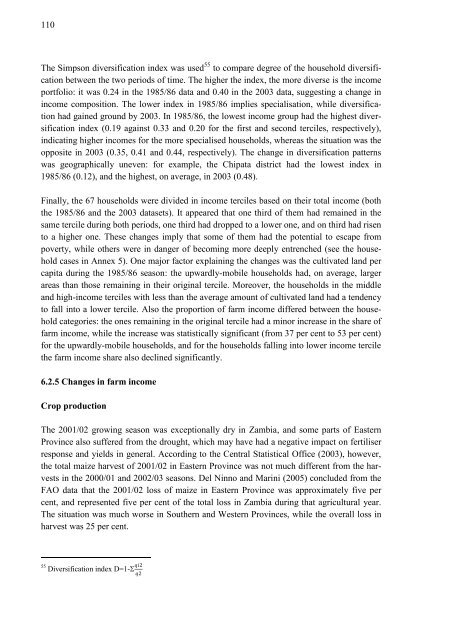Rural Income Generation and Diversification - A Case Study ... - Doria
Rural Income Generation and Diversification - A Case Study ... - Doria
Rural Income Generation and Diversification - A Case Study ... - Doria
You also want an ePaper? Increase the reach of your titles
YUMPU automatically turns print PDFs into web optimized ePapers that Google loves.
110<br />
The Simpson diversification index was used 55 to compare degree of the household diversification<br />
between the two periods of time. The higher the index, the more diverse is the income<br />
portfolio: it was 0.24 in the 1985/86 data <strong>and</strong> 0.40 in the 2003 data, suggesting a change in<br />
income composition. The lower index in 1985/86 implies specialisation, while diversification<br />
had gained ground by 2003. In 1985/86, the lowest income group had the highest diversification<br />
index (0.19 against 0.33 <strong>and</strong> 0.20 for the first <strong>and</strong> second terciles, respectively),<br />
indicating higher incomes for the more specialised households, whereas the situation was the<br />
opposite in 2003 (0.35, 0.41 <strong>and</strong> 0.44, respectively). The change in diversification patterns<br />
was geographically uneven: for example, the Chipata district had the lowest index in<br />
1985/86 (0.12), <strong>and</strong> the highest, on average, in 2003 (0.48).<br />
Finally, the 67 households were divided in income terciles based on their total income (both<br />
the 1985/86 <strong>and</strong> the 2003 datasets). It appeared that one third of them had remained in the<br />
same tercile during both periods, one third had dropped to a lower one, <strong>and</strong> on third had risen<br />
to a higher one. These changes imply that some of them had the potential to escape from<br />
poverty, while others were in danger of becoming more deeply entrenched (see the household<br />
cases in Annex 5). One major factor explaining the changes was the cultivated l<strong>and</strong> per<br />
capita during the 1985/86 season: the upwardly-mobile households had, on average, larger<br />
areas than those remaining in their original tercile. Moreover, the households in the middle<br />
<strong>and</strong> high-income terciles with less than the average amount of cultivated l<strong>and</strong> had a tendency<br />
to fall into a lower tercile. Also the proportion of farm income differed between the household<br />
categories: the ones remaining in the original tercile had a minor increase in the share of<br />
farm income, while the increase was statistically significant (from 37 per cent to 53 per cent)<br />
for the upwardly-mobile households, <strong>and</strong> for the households falling into lower income tercile<br />
the farm income share also declined significantly.<br />
6.2.5 Changes in farm income<br />
Crop production<br />
The 2001/02 growing season was exceptionally dry in Zambia, <strong>and</strong> some parts of Eastern<br />
Province also suffered from the drought, which may have had a negative impact on fertiliser<br />
response <strong>and</strong> yields in general. According to the Central Statistical Office (2003), however,<br />
the total maize harvest of 2001/02 in Eastern Province was not much different from the harvests<br />
in the 2000/01 <strong>and</strong> 2002/03 seasons. Del Ninno <strong>and</strong> Marini (2005) concluded from the<br />
FAO data that the 2001/02 loss of maize in Eastern Province was approximately five per<br />
cent, <strong>and</strong> represented five per cent of the total loss in Zambia during that agricultural year.<br />
The situation was much worse in Southern <strong>and</strong> Western Provinces, while the overall loss in<br />
harvest was 25 per cent.<br />
55 <strong>Diversification</strong> index D=1-

















